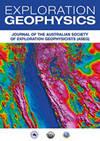提高基性火成岩单元下成像的地震采集参数:来自澳大利亚西北大陆架的案例研究
IF 0.8
4区 地球科学
Q4 GEOCHEMISTRY & GEOPHYSICS
引用次数: 1
摘要
沉积盆地内的镁铁质火成岩单元可能分布广泛,并严重削弱地震反射数据。衰减掩盖了亚火成沉积单元的成像,阻碍了远景和边界盆地的勘探。这项研究比较了历史上的2D地震调查,发现两个地震采集参数在澳大利亚西北陆架近海和陆上盆地的镁铁质火成岩下成像时影响最大。这些参数是通过使用三维模型在Browse、North Carnarvon、陆上和海上Canning盆地中使用集成的二维地震和井数据开发的。同时比较了三维空间中的二维地震线,结果表明,具有最长拖缆长度和最多接收器的勘测在火成岩单元下成像最有效。此外,我们从区域基底图中确定了被火成岩层位遮蔽的潜在沉积中心。这些沉积中心与较老的盆地相关,这些盆地被前裂谷、古生代沉积物填充,并被二叠纪晚期中生代裂谷事件期间形成的镁铁质火成岩覆盖。西北大陆架的大部分地区保持着边界地位,但勘探成果可以改善。因此,最大限度地延长拖缆长度和接收器数量,以进行未来的地震勘测,可以在已知火成岩存在的盆地中获得更有效的勘探机会。本文章由计算机程序翻译,如有差异,请以英文原文为准。
Seismic acquisition parameters to improve imaging beneath mafic igneous units: case study from Australia’s Northwest Shelf
Mafic igneous units within sedimentary basins can be widespread and severely attenuate seismic reflection data. Attenuation obscures imaging of sub-igneous sedimentary units, impeding exploration in prospective and frontier basins. This study compared historical 2D seismic surveys and found two seismic acquisition parameters that have the greatest influence when imaging beneath mafic igneous rocks in offshore and onshore basins from Australia’s Northwest Shelf. These parameters were found by using a 3D model developed with integrated 2D seismic and well data in the Browse, North Carnarvon, Onshore and Offshore Canning basins. Simultaneously comparing the 2D seismic lines in 3D space revealed that the surveys with the longest, streamer length and the most receivers are the most effective at imaging beneath igneous units. Additionally, we identified potential depocenters obscured by igneous horizons from a regional basement map. These depocenters correlate with older basins that are infilled by pre-rift, Paleozoic sediment and capped by mafic igneous rocks formed during late Permian-Mesozoic rifting events. Much of the Northwest Shelf maintains a frontier status, but exploration outcomes can be improved. Therefore, maximising streamer length and number of receivers to future seismic surveys can result in more effective exploration opportunities in basins with known igneous occurrences.
求助全文
通过发布文献求助,成功后即可免费获取论文全文。
去求助
来源期刊

Exploration Geophysics
地学-地球化学与地球物理
CiteScore
2.30
自引率
0.00%
发文量
33
审稿时长
>12 weeks
期刊介绍:
Exploration Geophysics is published on behalf of the Australian Society of Exploration Geophysicists (ASEG), Society of Exploration Geophysics of Japan (SEGJ), and Korean Society of Earth and Exploration Geophysicists (KSEG).
The journal presents significant case histories, advances in data interpretation, and theoretical developments resulting from original research in exploration and applied geophysics. Papers that may have implications for field practice in Australia, even if they report work from other continents, will be welcome. ´Exploration and applied geophysics´ will be interpreted broadly by the editors, so that geotechnical and environmental studies are by no means precluded.
Papers are expected to be of a high standard. Exploration Geophysics uses an international pool of reviewers drawn from industry and academic authorities as selected by the editorial panel.
The journal provides a common meeting ground for geophysicists active in either field studies or basic research.
 求助内容:
求助内容: 应助结果提醒方式:
应助结果提醒方式:


